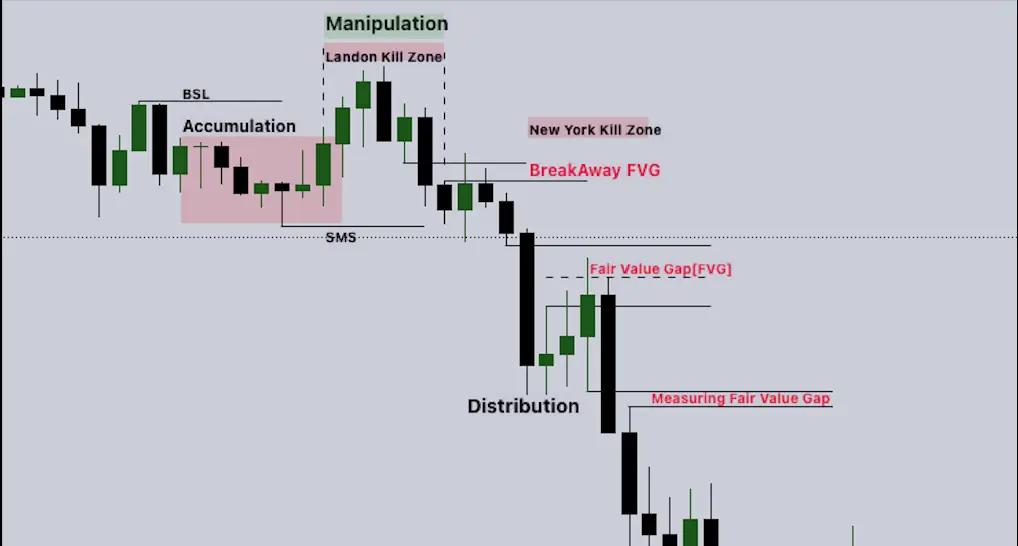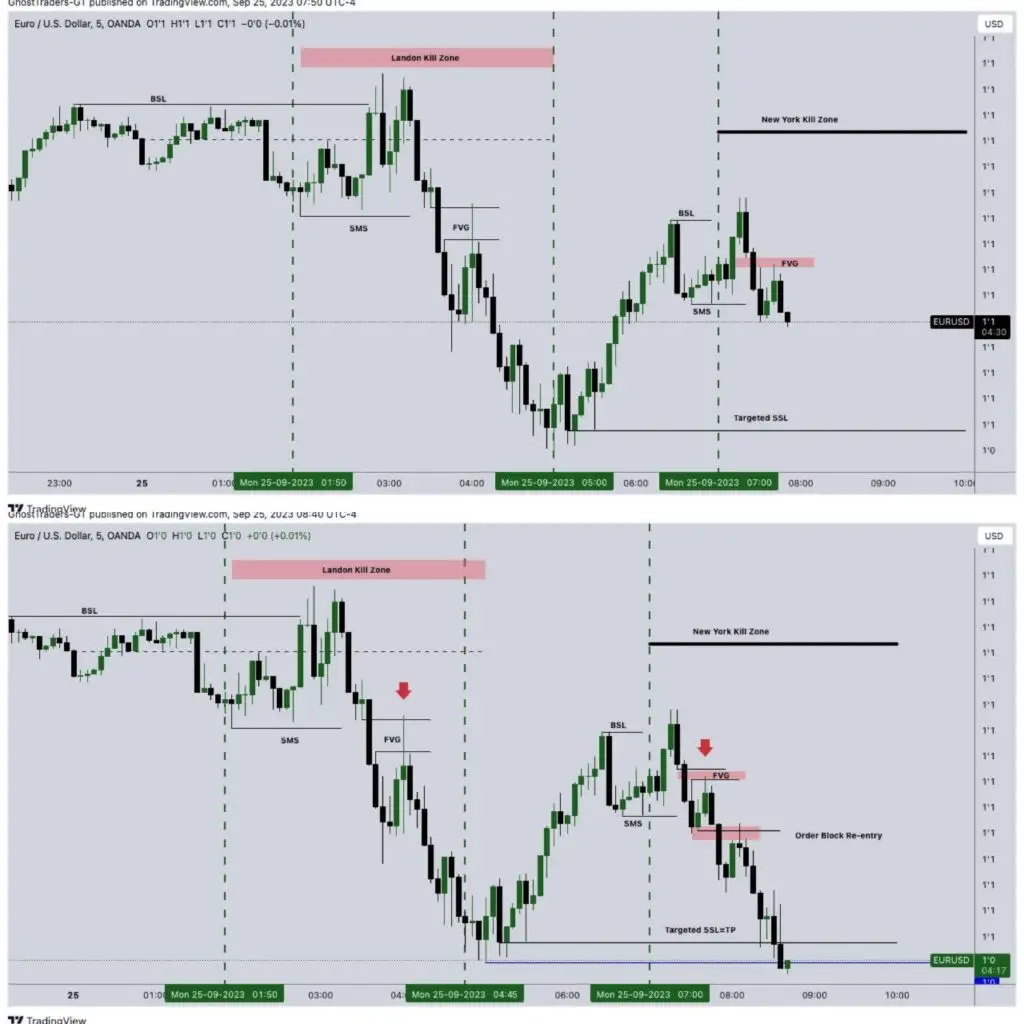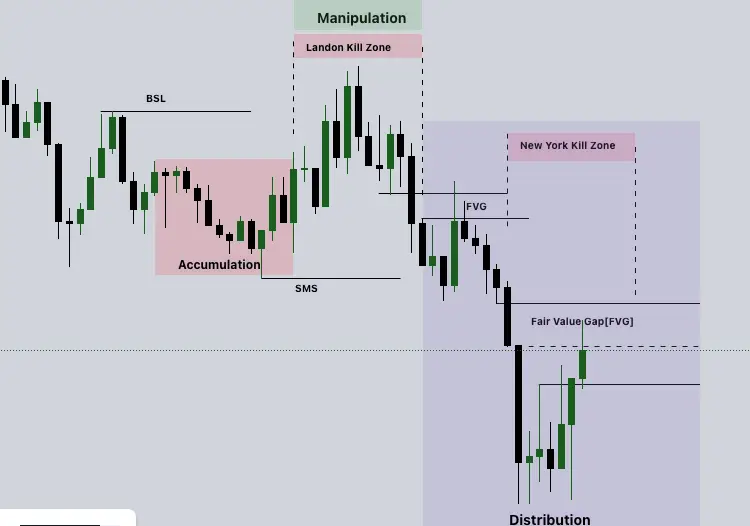What is Market Structure Shift

Before diving into market structure shifts, it’s essential to understand what market structure itself is. Market structure refers to the sequence of swing highs and swing lows that a price forms over time. These movements define the trend of the market—whether it’s in an uptrend, downtrend, or ranging.
- Uptrend: A sequence of higher highs and higher lows.
- Downtrend: A sequence of lower highs and lower lows.
- Range: A horizontal or sideways market with no distinct trend.
Market structure is critical because it reflects the supply and demand dynamics driving price movement. For instance, an uptrend signifies more demand (buyers in control), while a downtrend reflects more supply (sellers in control).

Before diving into market structure shifts, it’s essential to understand what market structure itself is. Market structure refers to the sequence of swing highs and swing lows that a price forms over time. These movements define the trend of the market—whether it’s in an uptrend, downtrend, or ranging.
- Uptrend: A sequence of higher highs and higher lows.
- Downtrend: A sequence of lower highs and lower lows.
- Range: A horizontal or sideways market with no distinct trend.
Market structure is critical because it reflects the supply and demand dynamics driving price movement. For instance, an uptrend signifies more demand (buyers in control), while a downtrend reflects more supply (sellers in control).
Defining a Market Structure Shift (MSS)
A Market Structure Shift (MSS) occurs when the established trend breaks and transitions into a new trend. This shift signals that the previous trend is likely ending, and a reversal or consolidation phase is starting. These shifts are especially important because they indicate that institutional traders—commonly referred to as “smart money”—are positioning themselves for a change in market direction.
A Market Structure Shift (MSS) occurs when the established trend breaks and transitions into a new trend. This shift signals that the previous trend is likely ending, and a reversal or consolidation phase is starting. These shifts are especially important because they indicate that institutional traders—commonly referred to as “smart money”—are positioning themselves for a change in market direction.
Here are the key signs of an MSS:
- In an uptrend: A break below a previous higher low signals a potential market structure shift, indicating that the bulls are losing control and sellers may soon dominate.
- In a downtrend: A break above a previous lower high signals a market structure shift, indicating that sellers are losing control, and buyers may take over.
The shift represents the transition between institutional accumulation and distribution, revealing where institutions are absorbing or offloading their positions.
- In an uptrend: A break below a previous higher low signals a potential market structure shift, indicating that the bulls are losing control and sellers may soon dominate.
- In a downtrend: A break above a previous lower high signals a market structure shift, indicating that sellers are losing control, and buyers may take over.
The shift represents the transition between institutional accumulation and distribution, revealing where institutions are absorbing or offloading their positions.
The Anatomy of a Market Structure Shift
Understanding the anatomy of an MSS helps traders spot trend reversals early, allowing for high probability entry points. Here’s what typically happens during a market structure shift:
- Break of Structure (BOS):
The BOS is the first major signal that the current trend is weakening. In an uptrend, this would be a break below the most recent swing low, while in a downtrend, it’s a break above the most recent swing high. The BOS indicates that the market is ready to move in the opposite direction. - Change of Character (CHOCH):
The CHOCH occurs when the market starts forming a series of new swing highs or lows that contradict the previous trend. For example, after a break of structure in an uptrend, the price starts making lower highs, indicating a potential change from bullish to bearish sentiment. - Liquidity Grab or Stop Hunt:
Often, before the market structure shifts, institutional traders trigger a liquidity grab. This involves price briefly spiking above a previous high (in a downtrend) or below a previous low (in an uptrend) to sweep liquidity. Once the liquidity is captured, the market then reverses sharply, causing a true shift in market structure.
Understanding the anatomy of an MSS helps traders spot trend reversals early, allowing for high probability entry points. Here’s what typically happens during a market structure shift:
- Break of Structure (BOS):
The BOS is the first major signal that the current trend is weakening. In an uptrend, this would be a break below the most recent swing low, while in a downtrend, it’s a break above the most recent swing high. The BOS indicates that the market is ready to move in the opposite direction. - Change of Character (CHOCH):
The CHOCH occurs when the market starts forming a series of new swing highs or lows that contradict the previous trend. For example, after a break of structure in an uptrend, the price starts making lower highs, indicating a potential change from bullish to bearish sentiment. - Liquidity Grab or Stop Hunt:
Often, before the market structure shifts, institutional traders trigger a liquidity grab. This involves price briefly spiking above a previous high (in a downtrend) or below a previous low (in an uptrend) to sweep liquidity. Once the liquidity is captured, the market then reverses sharply, causing a true shift in market structure.
How Institutions Use Market Structure Shifts
Institutional traders use market structure shifts as a signal to accumulate or distribute positions. Because institutions trade in large volumes, they require liquidity to enter or exit the market efficiently. A market structure shift provides this liquidity by creating volatility around key price levels.
Institutional traders use market structure shifts as a signal to accumulate or distribute positions. Because institutions trade in large volumes, they require liquidity to enter or exit the market efficiently. A market structure shift provides this liquidity by creating volatility around key price levels.
Here’s how institutions exploit MSS:
- Uptrend to Downtrend Shift:
Institutions may start selling or distributing their positions when they see signs of a weakening uptrend (e.g., a break of the last higher low). They also may trigger stop-hunts to create liquidity, allowing them to offload their positions at higher prices. - Downtrend to Uptrend Shift:
Similarly, when the market shifts from a downtrend to an uptrend, institutions are likely to accumulate long positions. They might break the structure of the downtrend by pushing price above the most recent lower high, triggering stop losses and creating a liquidity pool for their entries.
By identifying market structure shifts, retail traders can align their trades with smart money, increasing the likelihood of catching a trend early and avoiding being trapped in false moves.
- Uptrend to Downtrend Shift:
Institutions may start selling or distributing their positions when they see signs of a weakening uptrend (e.g., a break of the last higher low). They also may trigger stop-hunts to create liquidity, allowing them to offload their positions at higher prices. - Downtrend to Uptrend Shift:
Similarly, when the market shifts from a downtrend to an uptrend, institutions are likely to accumulate long positions. They might break the structure of the downtrend by pushing price above the most recent lower high, triggering stop losses and creating a liquidity pool for their entries.
By identifying market structure shifts, retail traders can align their trades with smart money, increasing the likelihood of catching a trend early and avoiding being trapped in false moves.
Spotting a Market Structure Shift on the Chart
To identify a market structure shift, follow these steps:
- Identify the Trend:
Determine whether the market is in an uptrend, downtrend, or range by observing the sequence of highs and lows. - Look for Key Structural Points:
Spot recent swing highs and swing lows, as these points will be critical in determining whether a market structure shift is about to occur. - Wait for a Break of Structure (BOS):
A market structure shift typically begins with a BOS. If the market is in an uptrend, look for the price to break below the most recent higher low. In a downtrend, look for the price to break above the most recent lower high. - Confirm the Shift with a Change of Character (CHOCH):
Once the BOS occurs, observe how the price behaves. If the price starts forming lower highs in an uptrend or higher lows in a downtrend, this confirms the change of character, indicating that the market structure has truly shifted. - Monitor for a Liquidity Grab:
Before the true market structure shift, institutions often push the price into liquidity zones to trigger stop-hunts. For example, in an uptrend, the price may briefly spike above the previous high to capture liquidity before reversing into a downtrend.
To identify a market structure shift, follow these steps:
- Identify the Trend:
Determine whether the market is in an uptrend, downtrend, or range by observing the sequence of highs and lows. - Look for Key Structural Points:
Spot recent swing highs and swing lows, as these points will be critical in determining whether a market structure shift is about to occur. - Wait for a Break of Structure (BOS):
A market structure shift typically begins with a BOS. If the market is in an uptrend, look for the price to break below the most recent higher low. In a downtrend, look for the price to break above the most recent lower high. - Confirm the Shift with a Change of Character (CHOCH):
Once the BOS occurs, observe how the price behaves. If the price starts forming lower highs in an uptrend or higher lows in a downtrend, this confirms the change of character, indicating that the market structure has truly shifted. - Monitor for a Liquidity Grab:
Before the true market structure shift, institutions often push the price into liquidity zones to trigger stop-hunts. For example, in an uptrend, the price may briefly spike above the previous high to capture liquidity before reversing into a downtrend.
Trading the Market Structure Shift
Trading market structure shifts is a strategy that allows traders to enter at key points of a new trend, typically aligning with institutional moves. Here’s how to trade an MSS effectively:
- Enter on the Retest:
After the initial break of structure, wait for a retest of the broken structure (e.g., a former higher low now acting as resistance in an uptrend). This retest often provides a high-probability entry point, as it confirms the shift in market sentiment. - Use Stop-Loss Beyond Liquidity Zones:
Place your stop-loss orders beyond liquidity zones to avoid being caught in a stop-hunt. For example, in a downtrend, place your stop-loss above the previous swing high where liquidity may be targeted. - Target Key Levels:
Set your take-profit levels at significant support or resistance zones or liquidity pools. These are often areas where the market will pause or reverse. - Risk Management:
Market structure shifts can lead to significant reversals, but they can also result in false moves. Always maintain strict risk management protocols by limiting your risk per trade and ensuring that your risk-to-reward ratio is favorable (e.g., at least 1:2 or 1:3).
Trading market structure shifts is a strategy that allows traders to enter at key points of a new trend, typically aligning with institutional moves. Here’s how to trade an MSS effectively:
- Enter on the Retest:
After the initial break of structure, wait for a retest of the broken structure (e.g., a former higher low now acting as resistance in an uptrend). This retest often provides a high-probability entry point, as it confirms the shift in market sentiment. - Use Stop-Loss Beyond Liquidity Zones:
Place your stop-loss orders beyond liquidity zones to avoid being caught in a stop-hunt. For example, in a downtrend, place your stop-loss above the previous swing high where liquidity may be targeted. - Target Key Levels:
Set your take-profit levels at significant support or resistance zones or liquidity pools. These are often areas where the market will pause or reverse. - Risk Management:
Market structure shifts can lead to significant reversals, but they can also result in false moves. Always maintain strict risk management protocols by limiting your risk per trade and ensuring that your risk-to-reward ratio is favorable (e.g., at least 1:2 or 1:3).
False Market Structure Shifts
Not every break of structure results in a true market structure shift. Smart money traders know how to identify false MSS, which are engineered to trap retail traders into bad positions. Here’s how to avoid falling into the trap:
- Beware of False Breakouts:
Often, the price will break a key level only to reverse back in the original direction. Wait for a confirmation of the change of character before entering the trade. - Watch for Volume:
A genuine market structure shift usually occurs with an increase in volume, as it reflects significant participation from institutional traders. A break of structure without volume confirmation could indicate a false move. - Monitor Price Action Around Key Levels:
If price action is indecisive or volatile around a structural point, it might signal a false break. In such cases, it’s best to wait for further confirmation before committing to a trade.
Not every break of structure results in a true market structure shift. Smart money traders know how to identify false MSS, which are engineered to trap retail traders into bad positions. Here’s how to avoid falling into the trap:
- Beware of False Breakouts:
Often, the price will break a key level only to reverse back in the original direction. Wait for a confirmation of the change of character before entering the trade. - Watch for Volume:
A genuine market structure shift usually occurs with an increase in volume, as it reflects significant participation from institutional traders. A break of structure without volume confirmation could indicate a false move. - Monitor Price Action Around Key Levels:
If price action is indecisive or volatile around a structural point, it might signal a false break. In such cases, it’s best to wait for further confirmation before committing to a trade.
Market Structure Shift in Ranging Markets
In ranging markets, market structure shifts are harder to spot, but they still occur. Here’s what to look for:
- Breakout of Range:
The price breaking out of a range can signify a potential market structure shift. However, always confirm the breakout by waiting for a retest or follow-through with volume. - Shift to Trending Market:
Once the price breaks out of the range, the market often shifts from consolidation to a trending phase. The market structure shift can act as an early signal of the beginning of a new trend.
In ranging markets, market structure shifts are harder to spot, but they still occur. Here’s what to look for:
- Breakout of Range:
The price breaking out of a range can signify a potential market structure shift. However, always confirm the breakout by waiting for a retest or follow-through with volume. - Shift to Trending Market:
Once the price breaks out of the range, the market often shifts from consolidation to a trending phase. The market structure shift can act as an early signal of the beginning of a new trend.
Conclusion
Understanding Market Structure Shifts is crucial for any trader looking to identify trend reversals and align themselves with institutional players. By recognizing the break of structure, change of character, and liquidity grabs, you can significantly improve your ability to anticipate market moves and enter high-probability trades.
As with all trading strategies, patience and confirmation are key. Wait for clear signs of a market structure shift before entering your trade, and always manage risk with proper stop-loss placement and position sizing. In doing so, you’ll be well-equipped to take advantage of market reversals and profit from smart money moves.
Understanding Market Structure Shifts is crucial for any trader looking to identify trend reversals and align themselves with institutional players. By recognizing the break of structure, change of character, and liquidity grabs, you can significantly improve your ability to anticipate market moves and enter high-probability trades.
As with all trading strategies, patience and confirmation are key. Wait for clear signs of a market structure shift before entering your trade, and always manage risk with proper stop-loss placement and position sizing. In doing so, you’ll be well-equipped to take advantage of market reversals and profit from smart money moves.



Post a Comment